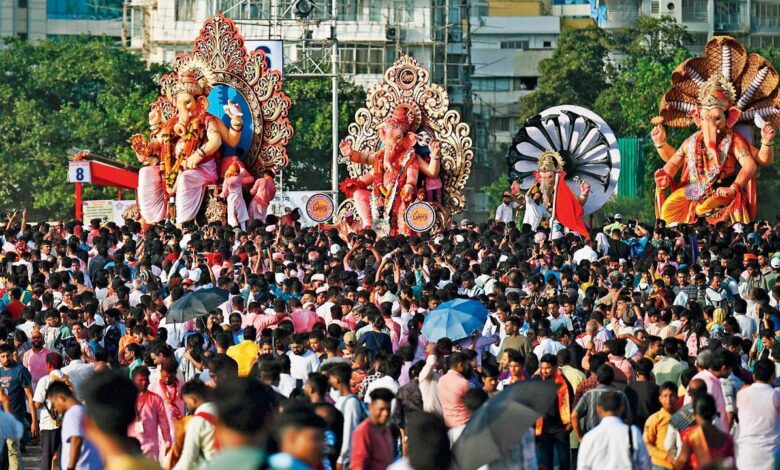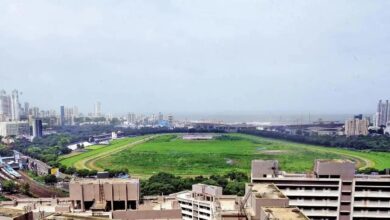Ganesh Visarjan 2024: ‘Noise lower than last year, but still above limit’

The Awaaz Foundation, led by environmental activist and anti-noise pollution campaigner Sumaira Abdulali, has released two in-depth reports, analysing noise pollution during the recent Ganesh visarjan and Eid-e-Milad celebrations in Mumbai. The reports stress that despite notable improvements, the need for stricter control over firecrackers and loudspeaker use to further reduce noise pollution in the city is needed.
Speaking to mid-day, Abdulali said, “The way we celebrated Ganesh Chaturthi in 2020 and 2021 became a testament to the positive change we, as a society, can achieve for the betterment of future generations. Unfortunately, the noise levels recorded in 2022 and 2023 showed a resurgence in noise pollution. This year, while the noise levels during Anant Chaturdashi and Eid-e-Milad were marginally lower compared to last year, they still remain above permissible limits. I plan to write to the chief minister to highlight this issue and emphasise the need for stronger efforts in managing the use of firecrackers and loudspeakers to protect public health and the environment.”
Noise levels
The report claims that on Tuesday (September 17), the last day of the festival, noise levels of 115 dB were recorded at Opera House junction after midnight, primarily due to firecrackers. Drums and loudspeakers also contributed significantly to the noise, with readings reaching 112.2 dB at Bandra West and 108.5 dB at Linking Road. Loudspeakers amplified speeches and performances, extending well past midnight in some locations, including Girgaon Chowpatty.
A decibel metre shows noise levels during the Ganesh visarjan reaching over 112 dB
“The report notes that while the 2024 noise levels are marginally lower than the 114.7 dB recorded in 2023, there is a significant improvement compared to earlier years, particularly 2019, when noise levels peaked at 121.3 dB. The absence of DJs, which had been a major source of noise in previous years, was a positive change, though firecrackers and loudspeakers remained prevalent sources of disruption,” said Abdulali.
The permissible noise levels in residential areas in Mumbai is 55 dB from 6 am to 10 pm and 45d B from 10 pm to 6 am. The Awaaz Foundation has been measuring noise levels from various sources since 2003, including festivals, religious places, political rallies, private events using loudspeakers or firecrackers, construction, traffic, railways and airports. The highest decibel level on the last day of visarjan in 2021 was 93.1 dB, it was 100.7 dB in 2020 and 121.3 dB in 2019. The highest ever noise level was recorded in 2015 at 123.7 dB followed by 2013 (123.2 dB).
Loudspeakers contribute
Eid-e-Milad processions were carried on across the city Wednesday with a recorded noise level of 101 dB along Mohammed Ali Road, primarily driven by speeches delivered via loudspeakers. This is a marked improvement from the 108.1 dB recorded in 2023, according to the report. The report further highlighted that the noise levels were generally lower across the city, with readings of 90 dB in Byculla and 85.5 dB in Bombay Central, reflecting more controlled use of loudspeakers.
Unlike Ganesh visarjan, where drums and firecrackers played a significant role, Eid-e-Milad processions were predominantly centered around speeches. A significant achievement in 2024 was the reduced use of DJs, with most processions opting for loudspeakers to broadcast speeches, leading to lower overall noise pollution. Abdulali said, “I will be writing to the chief minister to point out that amplification by loudspeakers, regardless of the source of noise, violates decibel levels. This is particularly important to note when speeches are continued past midnight, beyond the time limit for loudspeakers.
“In the years after COVID-19, it has been noted that in violation of noise rules and court orders, political parties continue to use loudspeakers well beyond midnight along the immersion route of processions. This year, too, the loudspeakers continued at high levels post midnight. Even though there were fewer DJs, amplification of music including drums and banjos through loudspeakers resulted in high noise levels at many processions.”
Key observations
Noise levels during the Ganesh visarjan reached a peak of 115 dB, primarily due to firecrackers while Eid-e-Milad recorded a peak of 101 dB, with loudspeakers driving the noise levels. During the visarjan, the usage of drums, firecrackers and loudspeakers with political speeches produced noises. While Eid-e-Milad relied more on loudspeakers for speeches, with minimal use of DJs and music, representing a more regulated approach. Ganesh visarjan saw a slight improvement, reducing peak noise from 114.7 dB in 2023 to 115 dB in 2024. While Eid-e-Milad experienced a more substantial reduction, lowering noise levels from 108.1 dB in 2023 to 101 dB in 2024.
What the regulations say
According to the Noise Pollution (Regulation and Control) Rules, 2000, residential areas should have a maximum noise level of 55 decibels (dB) in the day and 45 dB during the night. According to the World Health Organisation (WHO), noise levels less than 70 dB are not harmful to living organisms. Exposure for more than eight hours to constant noise beyond 85 dB may be hazardous. Whereas, continuous noise in the range of 100 dB-110 dB could result in ‘sensorineural hearing loss’.
Efforts to mitigate noise pollution
The above-mentioned reports emphasise the progress made in reducing the use of DJs, a major source of noise pollution, in previous years. The absence of DJs in most visarjans was a notable success, although the continued use of firecrackers and loudspeakers poses challenges. For Eid-e-Milad, the shift towards speeches and controlled use of loudspeakers was a positive step in managing noise levels during the celebrations.
Noise levels
Ganesh visarjan: 115 dB
Eid-e-Milad: 101 dB
Source link





